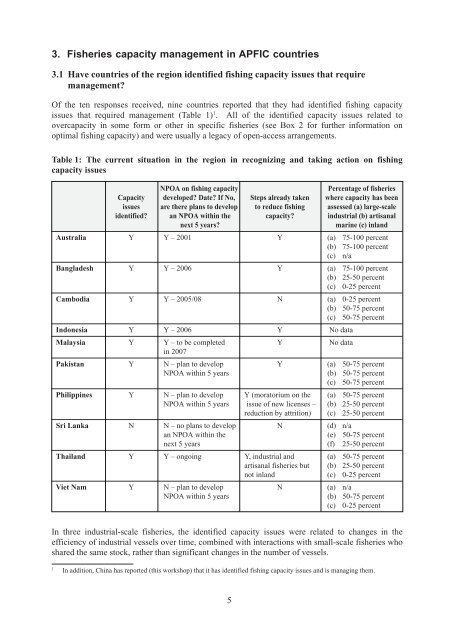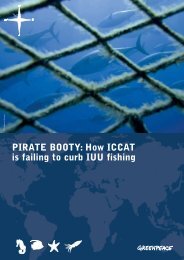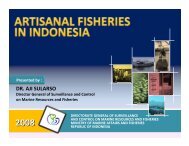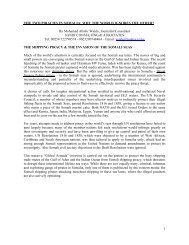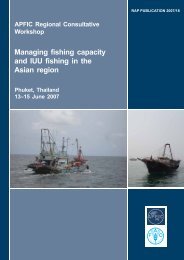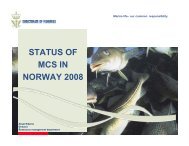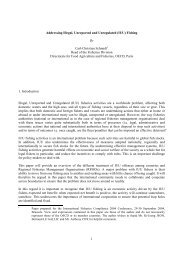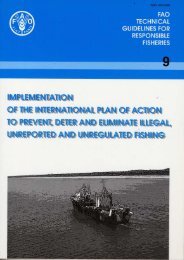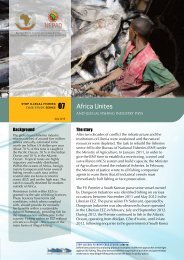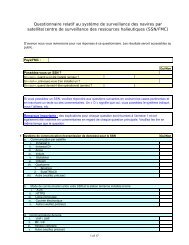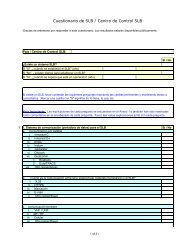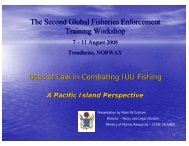Fishing capacity management and IUU fishing in Asia - FAO.org
Fishing capacity management and IUU fishing in Asia - FAO.org
Fishing capacity management and IUU fishing in Asia - FAO.org
You also want an ePaper? Increase the reach of your titles
YUMPU automatically turns print PDFs into web optimized ePapers that Google loves.
3. Fisheries <strong>capacity</strong> <strong>management</strong> <strong>in</strong> APFIC countries3.1 Have countries of the region identified <strong>fish<strong>in</strong>g</strong> <strong>capacity</strong> issues that require<strong>management</strong>?Of the ten responses received, n<strong>in</strong>e countries reported that they had identified <strong>fish<strong>in</strong>g</strong> <strong>capacity</strong>issues that required <strong>management</strong> (Table 1) 1 . All of the identified <strong>capacity</strong> issues related toover<strong>capacity</strong> <strong>in</strong> some form or other <strong>in</strong> specific fisheries (see Box 2 for further <strong>in</strong>formation onoptimal <strong>fish<strong>in</strong>g</strong> <strong>capacity</strong>) <strong>and</strong> were usually a legacy of open-access arrangements.Table 1: The current situation <strong>in</strong> the region <strong>in</strong> recogniz<strong>in</strong>g <strong>and</strong> tak<strong>in</strong>g action on <strong>fish<strong>in</strong>g</strong><strong>capacity</strong> issuesNPOA on <strong>fish<strong>in</strong>g</strong> <strong>capacity</strong>Percentage of fisheriesCapacity developed? Date? If No, Steps already taken where <strong>capacity</strong> has beenissues are there plans to develop to reduce <strong>fish<strong>in</strong>g</strong> assessed (a) large-scaleidentified? an NPOA with<strong>in</strong> the <strong>capacity</strong>? <strong>in</strong>dustrial (b) artisanalnext 5 years?mar<strong>in</strong>e (c) <strong>in</strong>l<strong>and</strong>Australia Y Y – 2001 Y (a) 75-100 percent(b) 75-100 percent(c) n/aBangladesh Y Y – 2006 Y (a) 75-100 percent(b) 25-50 percent(c) 0-25 percentCambodia Y Y – 2005/08 N (a) 0-25 percent(b) 50-75 percent(c) 50-75 percentIndonesia Y Y – 2006 Y No dataMalaysia Y Y – to be completed Y No data<strong>in</strong> 2007Pakistan Y N – plan to develop Y (a) 50-75 percentNPOA with<strong>in</strong> 5 years (b) 50-75 percent(c) 50-75 percentPhilipp<strong>in</strong>es Y N – plan to develop Y (moratorium on the (a) 50-75 percentNPOA with<strong>in</strong> 5 years issue of new licenses – (b) 25-50 percentreduction by attrition) (c) 25-50 percentSri Lanka N N – no plans to develop N (d) n/aan NPOA with<strong>in</strong> the (e) 50-75 percentnext 5 years (f) 25-50 percentThail<strong>and</strong> Y Y – ongo<strong>in</strong>g Y, <strong>in</strong>dustrial <strong>and</strong> (a) 50-75 percentartisanal fisheries but (b) 25-50 percentnot <strong>in</strong>l<strong>and</strong> (c) 0-25 percentViet Nam Y N – plan to develop N (a) n/aNPOA with<strong>in</strong> 5 years (b) 50-75 percent(c) 0-25 percentIn three <strong>in</strong>dustrial-scale fisheries, the identified <strong>capacity</strong> issues were related to changes <strong>in</strong> theefficiency of <strong>in</strong>dustrial vessels over time, comb<strong>in</strong>ed with <strong>in</strong>teractions with small-scale fisheries whoshared the same stock, rather than significant changes <strong>in</strong> the number of vessels.1In addition, Ch<strong>in</strong>a has reported (this workshop) that it has identified <strong>fish<strong>in</strong>g</strong> <strong>capacity</strong> issues <strong>and</strong> is manag<strong>in</strong>g them.5


